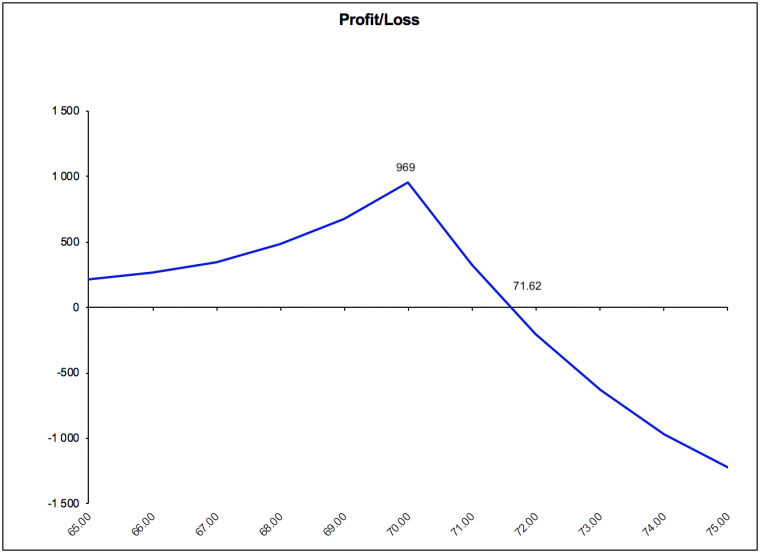A bearish diagonal spread on a resistance level

As the following chart shows, the price of shares in Bank of Nova Scotia (The) (BNS) has been on a downward trend over the last 12 months. Over the last few weeks, the price has stabilized in a corridor of $69 to $72, and it has faced resistance when it reached the 30-day moving average. The chart shows that, in the last year, every time the price rose above this moving average proved to be a good opportunity to sell the stock. As we say in the market, a trend will probably continue until it doesn’t anymore. As a result, an investor interested in taking advantage of this situation could implement a bearish diagonal spread, using put options. This moderately bearish strategy consists of buying a put and, at the same time, writing another put with a lower strike and a shorter expiration. Writing this put serves as a way to finance part of the purchase of puts and take advantage of time decay, which is faster on the option with the shorter expiration. The objective is for the option that you have written to expire with no value. This gives us a long position on the put options with a longer expiration, and we can then decide to hold onto them to profit from a declining stock price, sell them to realize a profit, if any, or write another put with a shorter expiration to offset even further the cost of the puts bought.

Position
- Purchase of 10 put options, BNS 190118 P 72, at $2.80
- Debit of $2,800
- Sale of 10 put options, BNS 181221 P 70, at $1.05
- Credit of $1,050
- Total debit of $1,750
Profit and loss diagram

We build this bearish diagonal spread by buying ten puts, BNS 190118 P 72, at $2.80 per share for a debit of $2,800 ($2.80 x 10 contracts x 100 shares per contract) and by writing ten puts, BNS 181221 P 70, at $1.05 per share for a credit of $1,050 ($1.05 x 10 contracts x 100 shares per contract). The total debit for the position of $1,750, or $1.75 per share, is also our potential maximum loss, which could arrive suddenly following any increase in the price of BNS above the break-even price of $71.62*. The position will be profitable as long as the price of BNS remains under this break-even price, with a maximum potential profit of $969* if the price of BNS is exactly $70, or the strike of the options written, when they expire on December 21, 2018.
Intervention
The following three scenarios describe further actions we can take, depending on how much the price of BNS rises between now and the options’ expiration on December 21, 2018 and depending on its closing price on that date.
Scenario #1
As we have recently seen, the price of BNS could well break above its 30-day moving average. Should this occur, the value of the puts that we wrote should fall. In this situation, we can consider buying back the puts we wrote if they can be bought for 10% to 20% of the selling price of $1.05, or at a price of $0.10 to $0.20. Then we could hold onto the January puts in order to take advantage of a subsequent price drop, or we could simply sell them to limit our losses if the scenario of a drop in price is no longer relevant.
Scenario #2
If on expiration on December 18, 2018 the price of BNS shares is still below the break-even price of $71.62 but above the $70 strike of the puts written, as in the previous scenario, we could then consider buying them back at a good price or letting them expire, with no value. We could then sell the options held at a profit, hold on to them to take advantage of a drop in price, or hold onto them and write more puts with a shorter expiration to further reduce the cost of the puts held.
Scenario #3
If on expiration on December 18, 2018, BNS shares are trading for less than the $70 strike of the puts written, the puts will be in the money and we will need to buy them back to avoid being assigned and forced to buy the shares for $70 (the strike). We will then be in the profit zone and, as in Scenario #2, we will have to decide whether we want to sell the puts held to realize a profit or hold onto them longer for a higher profit if the stock price falls even further. Another option is to hold onto them and write more options with a shorter expiration to further reduce the cost of the puts held.
*Note that the break-even price and maximum profit have been estimated based on the potential value of the puts held expiring in January 2019 on the expiration date of the puts written.
Good luck with your trading, and have a good week!
The strategies presented in this blog are for information and training purposes only, and should not be interpreted as recommendations to buy or sell any security. As always, you should ensure that you are comfortable with the proposed scenarios and ready to assume all the risks before implementing an option strategy.
President
Monetis Financial Corporation
Martin Noël earned an MBA in Financial Services from UQÀM in 2003. That same year, he was awarded the Fellow of the Institute of Canadian Bankers and a Silver Medal for his remarkable efforts in the Professional Banking Program. Martin began his career in the derivatives field in 1983 as an options market maker for options, on the floor at the Montréal Exchange and for various brokerage firms. He later worked as an options specialist and then went on to become an independent trader. In 1996, Mr. Noël joined the Montréal Exchange as the options market manager, a role that saw him contributing to the development of the Canadian options market. In 2001, he helped found the Montréal Exchange’s Derivatives Institute, where he acted as an educational advisor. Since 2005, Martin has been an instructor at UQÀM, teaching a graduate course on derivatives. Since May 2009, he has dedicated himself full-time to his position as the president of CORPORATION FINANCIÈRE MONÉTIS, a professional trading and financial communications firm. Martin regularly assists with issues related to options at the Montréal Exchange.
The information provided on this website, including financial and economic data, quotes and any analysis or interpretation thereof, is provided solely for information purposes and shall not be construed in any jurisdiction as providing any advice or recommendation with respect to the purchase or sale of any derivative instrument, underlying security or any other financial instrument or as providing legal, accounting, tax, financial or investment advice. Bourse de Montréal Inc. recommends that you consult your own advisors in accordance with your needs before making decision to take into account your particular investment objectives, financial situation and individual needs.
All references on this website to specifications, rules and obligations concerning a product are subject to the rules, policies and procedures of Bourse de Montréal Inc. and its clearinghouse, the Canadian Derivatives Clearing Corporation, which prevail over the content of this website. Although care has been taken in the preparation of the documents published on this website, Bourse de Montréal Inc. and/or its affiliates do not guarantee the accuracy or completeness of the information published on this website and reserve the right to amend or review, at any time and without prior notice, the content of these documents. Neither Bourse de Montréal Inc. nor any of its affiliates, directors, officers, employees or agents shall be liable for any damages, losses or costs incurred as a result of any errors or omissions on this website or of the use of or reliance upon any information appearing on this website.
BAX®, CADC®, CGB®, CGF®, CGZ®, LGB®, MX®, OBX®, OGB®, OIS-MX®, ONX®, SCF®, SXA®, SXB®, SXF®, SXH®, SXM®, SXO®, SXY®, and USX® are registered trademarks of the Bourse. OBW™, OBY™, OBZ™, SXK™, SXJ™, SXU™, SXV™, Montréal Exchange and the Montréal Exchange logo are trademarks of the Bourse. All other trademarks used are the property of their respective owners.
© 2024 Bourse de Montréal Inc. All Rights Reserved.
